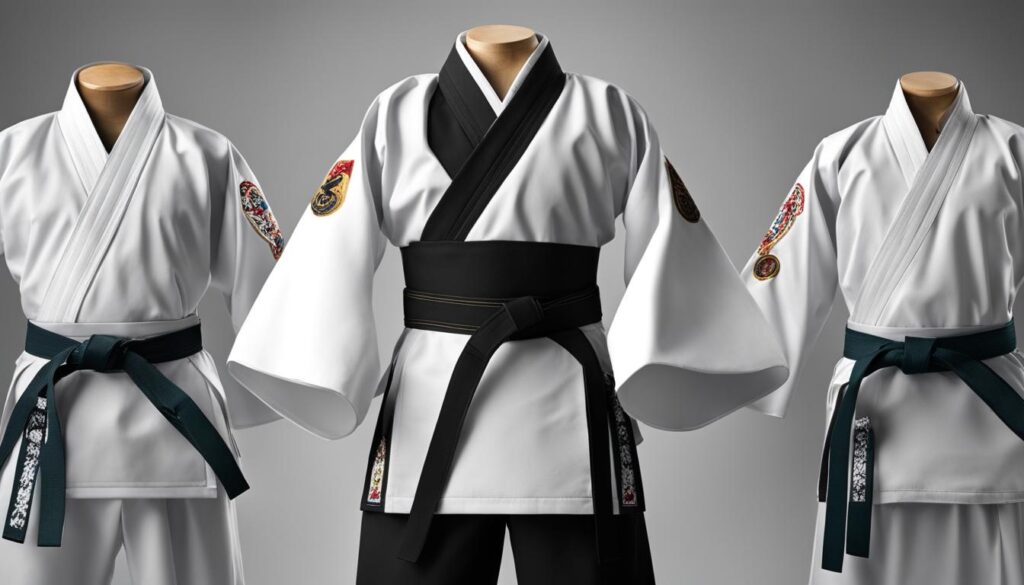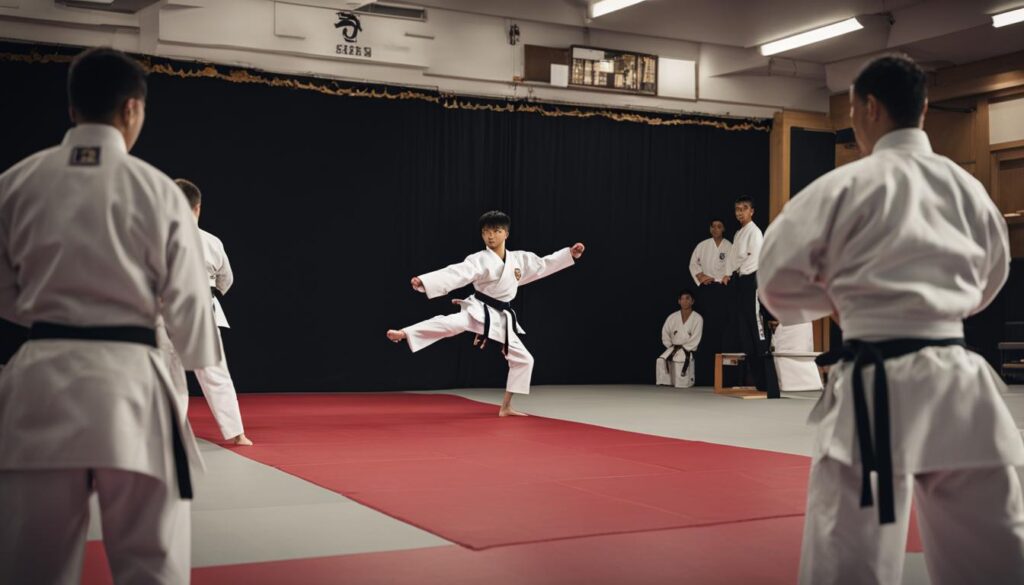Taekwondo is a Korean martial art known for its powerful kicks and striking techniques. Practitioners of Taekwondo wear a special uniform known as a dobok. In this article, we will explore the significance of the dobok in Taekwondo and its role in rank progression and grading.
Key Takeaways:
- The Taekwondo uniform is called a dobok.
- The dobok is a traditional attire in Korean martial arts.
- The design of the dobok carries deep symbolism based on Eastern philosophies.
- The dobok symbolizes rank, progression, and the values of Taekwondo.
- The dobok is an integral part of Taekwondo culture and grading systems.
The Significance of the Dobok Design in Taekwondo
In Taekwondo, the dobok is not just a uniform, but a representation of the core principles and values of this Korean martial art. The design of the dobok incorporates elements that hold profound significance in Eastern philosophies, particularly the concept of harmony in human life.
The dobok consists of three geometrical shapes that are strategically placed in different parts of the attire. The sleeves and trousers feature square patterns, symbolizing the Earth and its stability. The belt, often tied in a circular shape, represents humanity and its constant connection and interaction. Lastly, the V-neck and tights on the dobok form a triangle, signifying heaven and the realm of the divine.
According to the Yin and Yang theory, these three shapes, the square, circle, and triangle, represent the balance of opposing forces: Earth, people, and heaven. This design philosophy reflects the interconnectedness of the individual with their surroundings, emphasizing the importance of equilibrium and unity.
Furthermore, the dobok is predominantly white in color, which holds deep symbolism in Taekwondo. The white color signifies purity of consciousness and the pursuit of inner peace. It represents the practitioner’s commitment to moral integrity, discipline, and ethical conduct both inside and outside the training hall.
Through the thoughtful design and symbolism of the dobok, Taekwondo practitioners are reminded of the core values and philosophy that underpin this martial art. It serves as a constant reminder to practitioners to strive for balance, harmony, and purity in all aspects of their practice.
An image of a Taekwondo practitioner wearing a dobok, showcasing the significance of design and the traditional attire in Taekwondo.
The Dobok as a Symbol of Rank and Progression
In Taekwondo, the dobok is not only a uniform but also a symbol of rank and progression. As practitioners advance in their training, the color of their belt changes to reflect their progress. Taekwondo follows a ranking system with colored belts, starting from white for beginners and progressing through yellow, blue, red, and finally black. The black belt represents the highest level of achievement and mastery in Taekwondo.
The dobok, also known as a taekwondo gi or traditional taekwondo uniform, is an essential part of the dress code and training uniform in Taekwondo. It is designed to promote discipline, respect, and unity among practitioners.
Image:

Table: Belt Colors and their Significance in Taekwondo Rank Progression
| Belt Color | Rank |
|---|---|
| White | Beginner |
| Yellow | 10th to 9th Gup |
| Blue | 8th to 7th Gup |
| Red | 6th to 4th Gup |
| Black | 1st to 10th Dan |
The progression from white belt to black belt represents the growth, dedication, and mastery of the practitioner. It takes years of training, discipline, and perseverance to achieve the coveted black belt rank. As practitioners advance through the ranks, they not only gain technical proficiency but also cultivate invaluable qualities such as patience, humility, and self-control.
The dobok serves as a visual representation of the practitioner’s journey and accomplishments in Taekwondo. It serves as a reminder of the dedication and hard work put into achieving each rank.
The Dress Code: Tradition and Respect
Wearing the dobok as the taekwondo training uniform is not only a requirement but also a sign of respect for the art and its heritage. It reflects the values and traditions upheld in the martial art.
Practitioners are expected to adhere to a specific dress code during training, which includes wearing a clean and neatly pressed dobok. This maintains a sense of uniformity and discipline within the training environment.
The Differentiation of Doboks for Different Grades
The doboks in Taekwondo are distinguished based on the practitioner’s grade. For colored grades, a plain white dobok is the accepted uniform for all levels. The black belt grades, on the other hand, have specific differentiations.
The provisional or probationary black belt has a white top with no trim, while the first to fifth-degree black belts have a trim uniform with a black band around the V-neck collar. The sixth to ninth-degree black belts, known as Master and Grand Master ranks, have the freedom to choose their own uniform design within the organization’s guidelines.
In summary, the Taekwondo doboks vary based on the practitioner’s grade. While colored grades wear a plain white dobok, black belt grades have specific differentiations in design. The freedom to choose their own uniform design is given to the Master and Grand Master ranks. The dobok evolution showcases the rich history of Taekwondo uniform and its importance in signifying rank and progression.
Taekwondo Uniform Sizes and Shrinkage
Taekwondo uniforms, or doboks, are available in various sizes to accommodate both children and adults. These sizes cater to the diverse range of practitioners in Taekwondo, ensuring a comfortable and proper fit. Children’s doboks typically range from 110 to 150cm, while adult sizes vary from 160 to 200cm.
It is important to note that doboks, like many other uniforms, tend to shrink slightly during the first few washes. This shrinkage is primarily due to the high percentage of cotton used in the fabric. To ensure an optimal fit, it is recommended to select a dobok that is 5 to 10cm larger than your actual size. This allows for the anticipated shrinkage and ensures that the dobok remains suitable even after washing.
When choosing a dobok, it is crucial to consider the appropriate size to enhance comfort and mobility during training sessions and competitions. By selecting the correct size and accounting for possible shrinkage, practitioners can ensure that their doboks fit well and provide the freedom of movement necessary for executing Taekwondo techniques effectively.
The Role of the Dobok in Taekwondo Grading
The dobok, the traditional uniform in Taekwondo, plays a significant role in the grading process. As practitioners advance in their training and seek to progress to the next rank, the dobok becomes a visual representation of their skills and knowledge. In order to demonstrate their proficiency, they must present themselves in front of an official federation jury.
During the grading process, the color of the hem on the neck of the dobok holds great significance. For practitioners with colored belt grades, the hem is white, symbolizing their current level of achievement. However, from the 1st dan black belt onwards, the hem changes to black, signifying a higher level of mastery in Taekwondo.

As practitioners progress through the ranks, the dobok becomes a symbol of their dedication, discipline, and growth within the martial art. It embodies the values and principles upheld in Taekwondo, and its significance in grading serves as a constant reminder of the practitioner’s journey towards mastery.
The Evolution of Taekwondo Uniforms
The dobok, as the Taekwondo uniform, has a rich history and has undergone significant evolution over time. Initially, it was adopted from the traditional Korean costume and designed to incorporate the principles of Eastern philosophies. The dobok’s design reflects the harmony in human life, with different geometrical shapes symbolizing various elements.
As Taekwondo gained popularity globally, diverse variations in uniform design emerged. Different organizations and schools started incorporating their unique styles and color configurations into the dobok. These variations add a touch of individuality to the traditional white dobok, while still maintaining its essence and significance.
The traditional white dobok with specific trimmings and accessories continues to be respected and widely used in Taekwondo. However, the dobok’s evolution has given practitioners the freedom to personalize their uniforms within the guidelines set by their organization.
Conclusion
The Taekwondo uniform, known as a dobok, is an integral part of Taekwondo culture. It is not just a simple attire but a symbol of rank, progression, and the values upheld in Korean martial arts. The design of the dobok holds deep significance, inspired by the harmony in human life and rooted in Eastern philosophies.
As practitioners progress in their training, the dobok becomes a reflection of their level of mastery. The color of the belt changes, indicating the advancement and dedication of the individual. The dobok’s significance in grading highlights the importance of discipline, perseverance, and continuous learning in Taekwondo.
Over time, the dobok has evolved, adapting to the global spread of Taekwondo. While there may be variations in design and color configurations, the traditional white dobok with its symbolic trimmings and accessories remains widely respected and used. Its evolution showcases the rich history and cultural importance of the Taekwondo uniform, connecting practitioners to their heritage and the values they embody.
FAQ
What is the traditional attire in Korean martial arts called?
The traditional attire in Korean martial arts is called a dobok.
What does the dobok symbolize in Taekwondo?
The dobok symbolizes the unity and origin of the universe.
What are the design elements in a Taekwondo dobok?
The design of a Taekwondo dobok incorporates three geometrical shapes: square, circle, and triangle.
What does the white color of the dobok signify?
The white color of the dobok signifies purity of consciousness and peace.
How does the dobok represent rank and progression in Taekwondo?
As practitioners advance in their training, the color of their belt changes to reflect their progress.
How do doboks for black belt grades differ from colored grades?
For black belt grades, doboks have specific differentiations such as a black band trim on the V-neck collar.
What sizes are available for Taekwondo doboks?
Taekwondo doboks come in various sizes for children (110-150cm) and adults (160-200cm).
Is it normal for doboks to shrink after washing?
Yes, doboks tend to shrink a few centimeters during the first few washes due to the high percentage of cotton.
What is the significance of the dobok in Taekwondo grading?
The dobok plays a significant role in Taekwondo grading as the color of the hem on the neck changes according to the level.
How has the Taekwondo uniform evolved over time?
The Taekwondo uniform, or dobok, has evolved to include variations in design and color configurations as the martial art spread globally.
